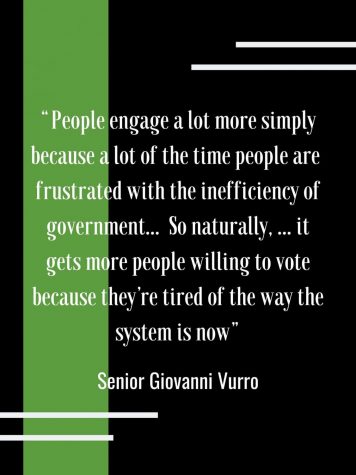The U.S. versus Italy: third-parties
Examining the detriments of America’s lack of third party engagement
December 13, 2019
 he post-antebellum American democracy has been characterized by the presence of two dominant political parties — the Democratic and Republican parties. Some, such as strong Democratic contender for the 2020 presidential election Bernie Sanders argue that “we need to change the power structure in America — we need to end the political oligarchy.”
he post-antebellum American democracy has been characterized by the presence of two dominant political parties — the Democratic and Republican parties. Some, such as strong Democratic contender for the 2020 presidential election Bernie Sanders argue that “we need to change the power structure in America — we need to end the political oligarchy.”
The presence of this duopoly, consequently, has led to an absence of extensive third party engagement in America, although there are third parties that exist, including the Green Party, the Libertarian Party and an upcoming group in California called the Common Sense Party.
In contrast, Italy, like many European countries, abides by a parliamentary system where there are a multitude of political parties. Especially in comparison to America, third party engagement and voter turnout is prevalent. A 2018 Pew Research Center study reported that 75.28% of voting age Italians voted in their 2018 elections, while 55.70% of voting age Americans voted in the 2016 elections. Additionally, a 2018 Gallup poll reported that 57% of Americans believe there is a need for at least one more major political party.
According to senior Giovanni Vurro, an Italian-Indian American, Italy’s system works better because it helps preserve the opinions of the diverse groups of people.
“A lot of people aren’t strictly Democrat or strictly Republican,” Vurro said. “And so by taking that out and not really recognizing all these third parties, you lose out on a lot of the public’s opinion.”
AP Government teacher Hilary Barron explains that because of the inherent structure of American politics, third parties have difficulty gaining traction. Unlike Italy’s system, where the system is proportional, America has what she calls “winner takes all elections,” where there is no room for second place.
“I think also, the Democrat and Republican parties have become such a big tent [that] they’ve kind of encompassed a lot of those third party ideas,” Barron said. “Instead of having multiple parties that are around a smaller group of issues, we have these two big, very broad, parties. [For instance], we have more moderate Republicans and more extreme Republicans, all in the same group. So I think people are finding at least some connection within those broader parties.”
Junior Nelson Mu is in support of the third parties in America, considering that they lead to more voices, especially ones that deviate from the mainstream Republican and Democrat party policies. However, Mu also asserts that he is more in favor of reforming the two existing dominant parties rather than consolidating support for fragmentary third parties that don’t have a shot at getting anywhere.
“Ideologically they have interesting viewpoints,” Mu said. “But realistically, and pragmatically, they’re not going to get anywhere so, personally, I don’t align with any of those. And honestly, I don’t align with any of the larger parties either simply because I’m not of voting age, so there’s not much point declaring that I’m one side or the other, when there isn’t a need for it.”
Additionally, Mu feels as though third party politics renders democracies as even more inefficient than they already tend to be. In a perfect democracy, he says, every person has no affiliation with the next. Husbands and wives don’t have similar political affiliations, friends don’t have similar affiliations, and so on. In essence, every person is single-minded and votes for exactly for what they believe in. However, Mu says that this is not practical — all 450 million people in the United States can’t have their own individual viewpoints — and therefore, compromise and a low number of political parties is necessary.
“Democracy is good, but efficiency is also important,” Mu said. “At the end of the day, I still think we should focus our efforts on either supporting one large party or another large party. We can’t have a bunch of small groups and give every single person that wants to have a say in the government by virtue of having their own party.”
Mu explains that the heightened efficiency of two-party politics is demonstrated by a major, contentious issue: Donald Trump’s impeachment. Since the House of Representatives is under Democratic control, they were able to coalesce and pass an impeachment bill, whereas in Italy, passing this would be more difficult due to a fragmented parliament.
Although Vurro cedes that inefficiency is a downside of multi-party politics, he also says that fragmentation is not always an issue because parties, when they have an overarching goal, tend to consolidate into coalitions. For instance, this consolidation is witnessed currently, where “Italy’s various political forces—right and left, north and south—are divided into 1 million pieces, but are revolving around one center of gravity: Matteo Salvini,” an unpopular far-right politician.
“[Parties] group together simply so that they can get the majority,” Vurro said. “So that’s something you rarely see here, because there’s only two parties, whereas [in Italy] you see parties that don’t even agree with each other putting that aside just to win a parliament majority over another candidate or party.”
Vurro adds that this is precisely why Italian voters tend to be more engaged and informed. Due to the abundance of parties and uncertainty of outcomes, Italians are therefore forced to keep up to date on political shifts and are more likely to connect with a party’s viewpoints.

“People engage a lot more simply because a lot of the time people are very frustrated with the inefficiency of government,” Vurro said. “So naturally, that kind of just spikes the conversation and gets more people talking, gets more people willing to vote because they’re tired of the way the system is now.”
In America, Vurro says, citizens assumedly feel a similar kind of frustration with the government, yet the two-party system has made voters more lax about engagement.
“People here are just complacent, and the fact that there’s two parties and it’s going to be one of the other,” Vurro said. “Whereas in Italy, you never really know which parties are going to form a coalition and try and win a majority, you don’t really know what’s happening, and so you have to stay involved and you have to get informed.”
Barron also adds that unlike America, in Italy the elections are not scheduled ahead of time, rendering them to be more exciting due to their spontaneity. In contrast, the rigid scheduling of elections in America can cause voters to get disengaged and burnt out.
However, Barron says there are ways to amend voter involvement. As a teacher, she has a strong faith in education’s power to get students more involved. She also points to social media, and a recent increase in the diversity of America’s politics — pointing to Alexandria Ocasio-Cortez, a New York U.S. House Representative, and Andrew Yang, a potential Democratic presidential nominee, as examples — as people that have been gaining more traction.
“I hope students are paying more attention to politics,” Barron said. “It is challenging to get started, but I feel like once you start to see the storylines, then it gets more interesting and you can follow the stories as they evolve. Once you have kind of a direction, then you start building that habit of getting a news update every day or being more engaged in what’s going on, and learning about how you can have power in a democracy.”


























